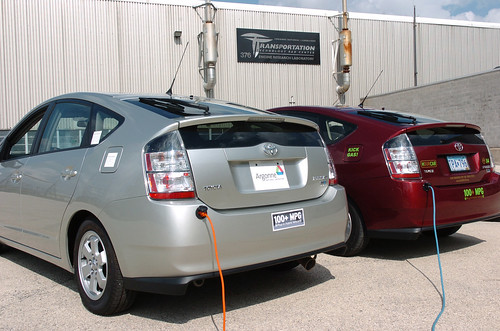Plug-In Prius Coming This Year; Toyota to Lease 200 PHEVs in Japan Starting at End of 2009, 500 Globally; Gen3 Prius Plus Li-ion Pack
(Source: Green Car Congress & Wired)
Toyota’s third-gen Prius is already a huge hit in Japan (topping the sales numbers for May), and the automaker plans to lease a plug-in version to corporate and municipal customers by the end of the year.
Just 200 are slated for release in Japan under a joint program with the Ministry of Economy, Trade and Industry aimed at promoting the adoption of plug-in hybrids and EVs. Although the new Prius – like all those that came before – uses a nickel metal hydride battery, the plug-in features a lithium-ion pack.
“Toyota Motor Corp. believes that, in response to the diversification of energy sources, plug-in hybrid vehicles are currently the most suitable environmentally considerate vehicles for widespread use,” the company said in a statement. “TMC therefore intends to encourage the marketing of plug-in hybrid vehicles while introducing a total of 500 vehicles globally—primarily to fleet customers—to further use and understanding of the vehicles.”
TMC will introduce approximately 150 plug-in hybrid electric vehicles in the United States, as well as more than 150 vehicles in Europe, including 100 in France. TMC is also considering introducing plug-in hybrid vehicles in the United Kingdom, the Netherlands and Germany.
In announcing the Japan lease program, Toyota said that:
TMC has positioned hybrid technologies as core environmentally considerate vehicle technologies and is using them in the development not only of plug-in hybrid vehicles but also electric vehicles and fuel-cell hybrid vehicles. TMC will continue its efforts to achieve sustainable mobility by developing and putting into practical use these next-generation vehicles, which are hoped to contribute to reducing petroleum consumption, reducing CO2 emissions and responding to the diversification of energy sources.
Toyota said that the plug-ins will operate as electric vehicles when used for “short distances” and operate as conventional hybrids when used for medium to long-distance trips.
Toyota has been testing an earlier plug-in prototype featuring a large NiMH pack rather than the proposed Li-ion pack, with an electric range of approximately 13 km (8 miles) under the Japan 10-15 cycle (Earlier post.)
The Japan lease program is in collaboration with local governments selected under the Japanese Ministry of Economy, Trade and Industry’s EV & PHV Towns program, which aims to promote the widespread use of electric vehicles and plug-in hybrid vehicles.
The program features an intensive program for the introduction and promotion of electric vehicles and plug-in hybrid vehicles as well as accelerating the setting up of charging infrastructures and the development of societal awareness and preparedness through the collaboration of the national and local governments, regional businesses and auto manufacturers in Japan.
Plug-ins are touted for triple-digit fuel economy, but a test fleet of 17 plug-in Prius hybrids in the Seattle area has achieved an average of just 51 mpg. Officials there and plug-in advocates said the problem lies with driver behavior, not the technology.




